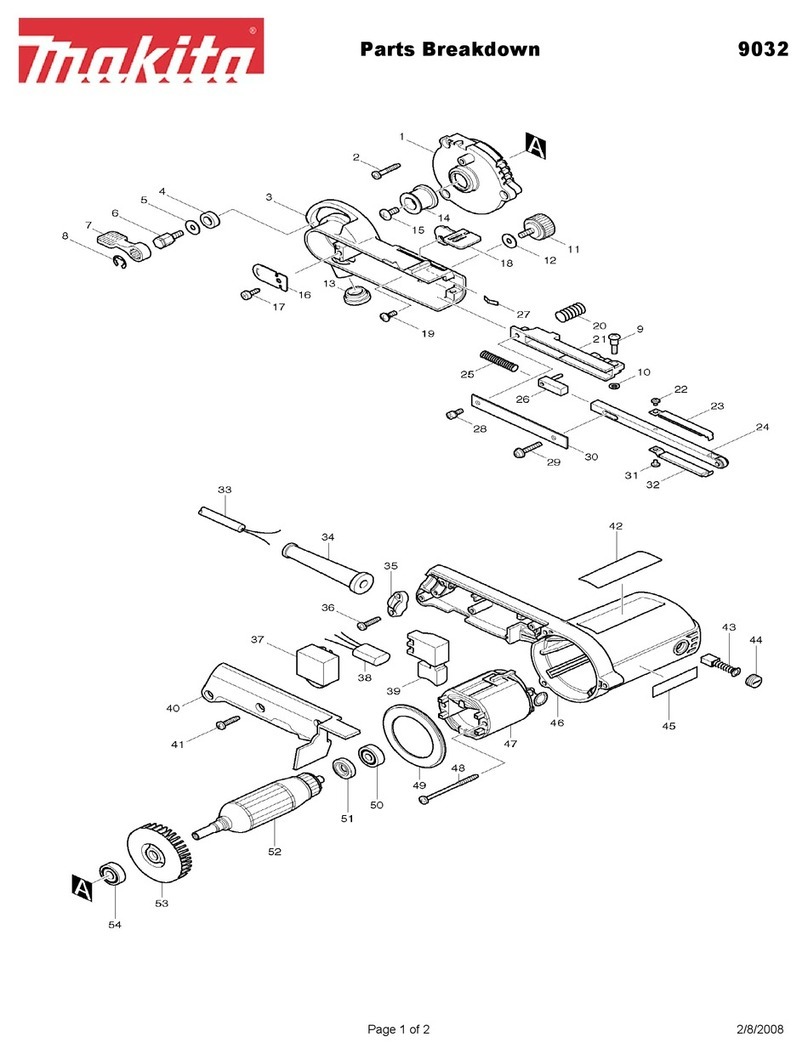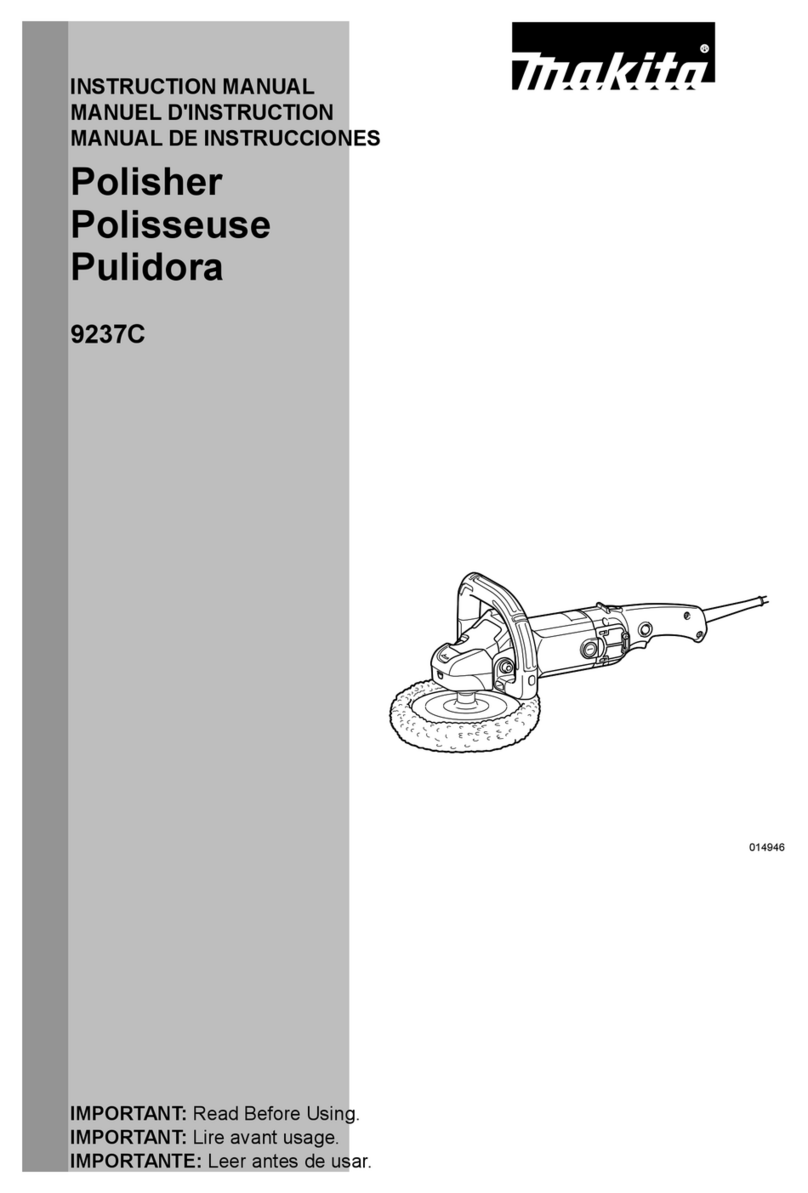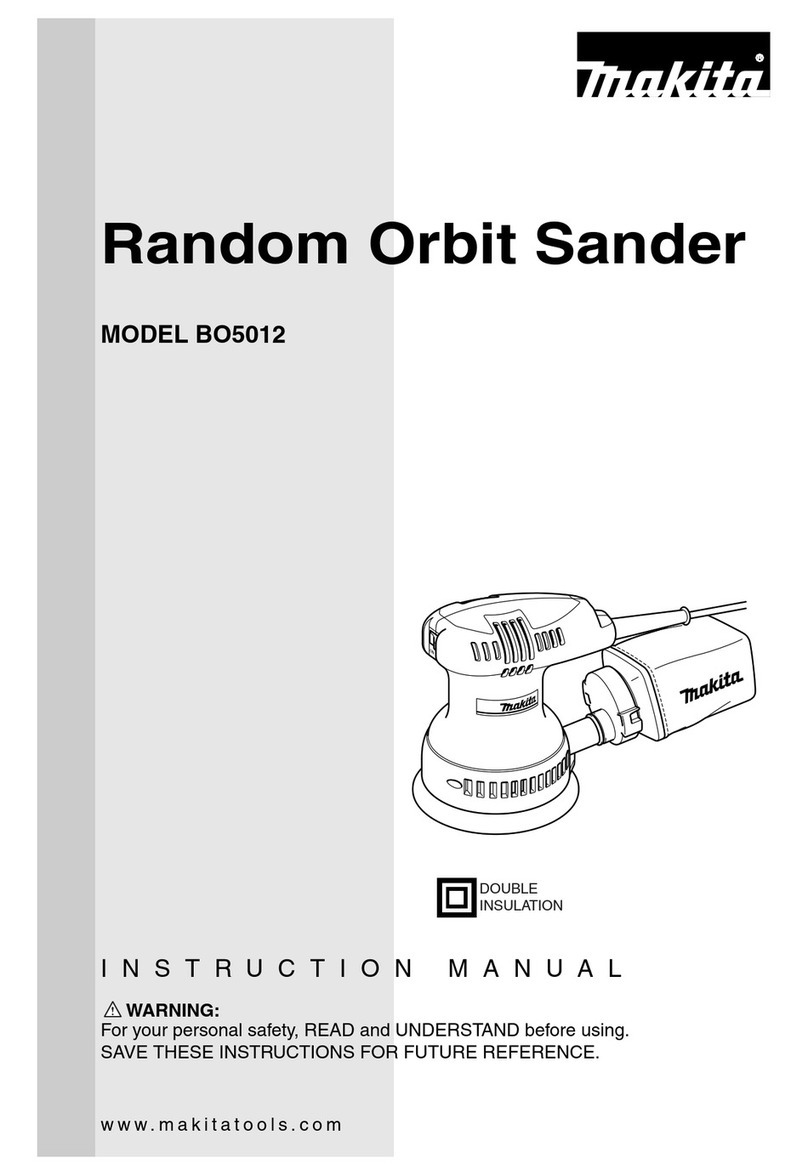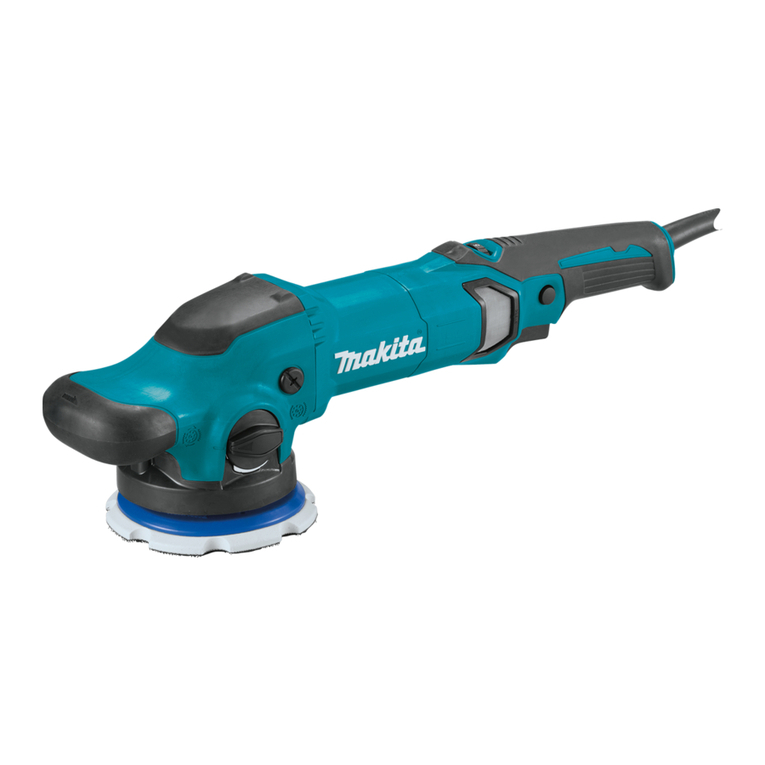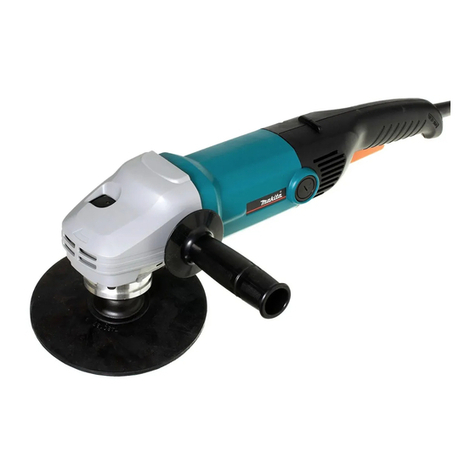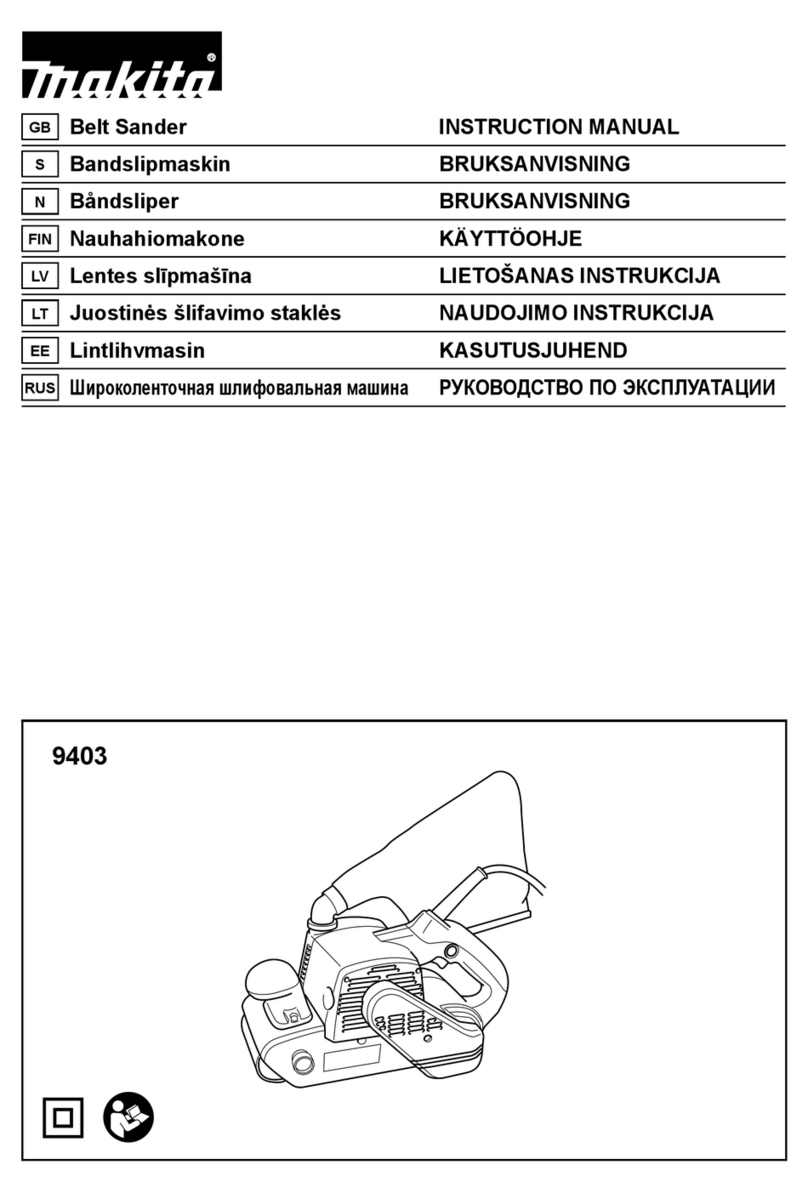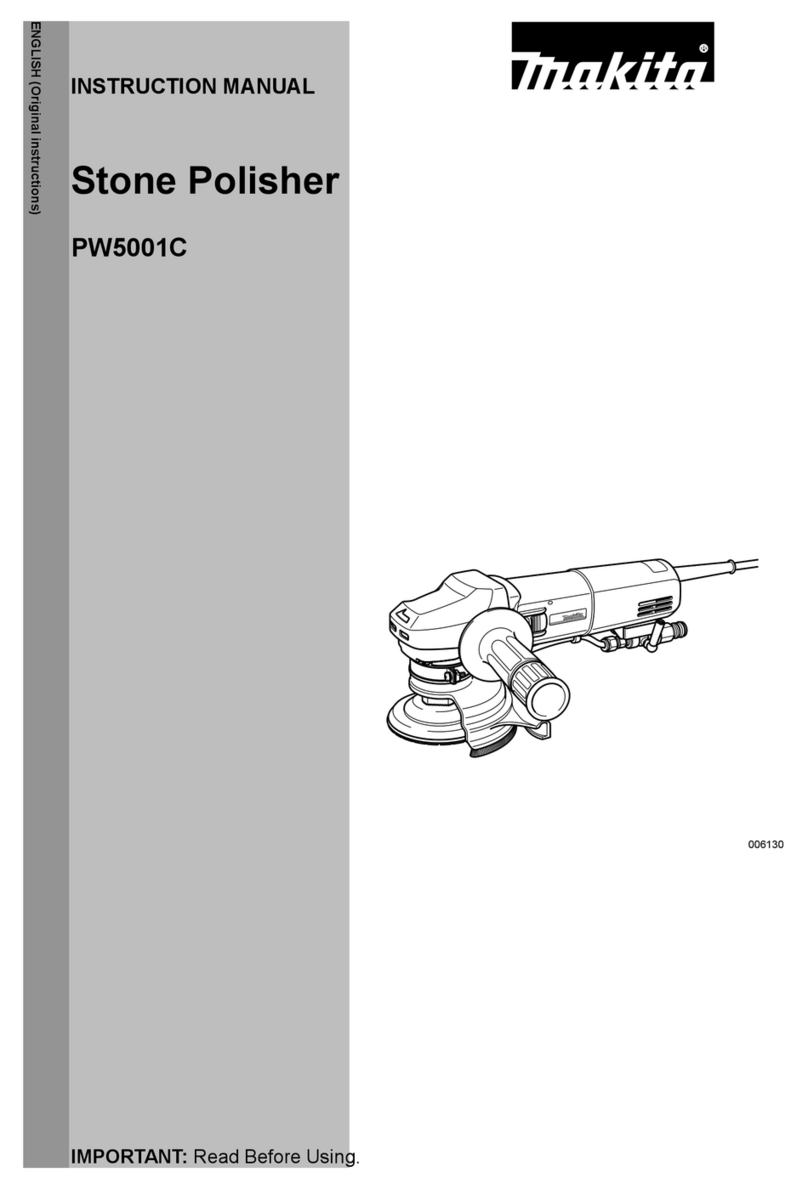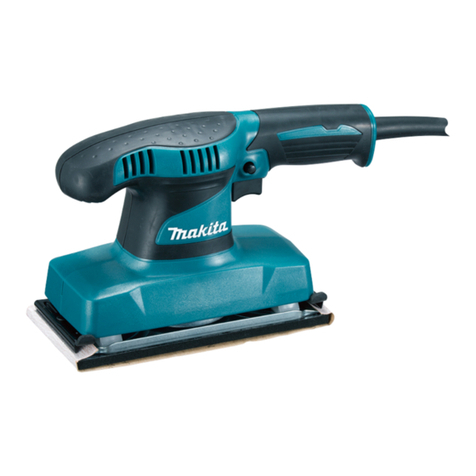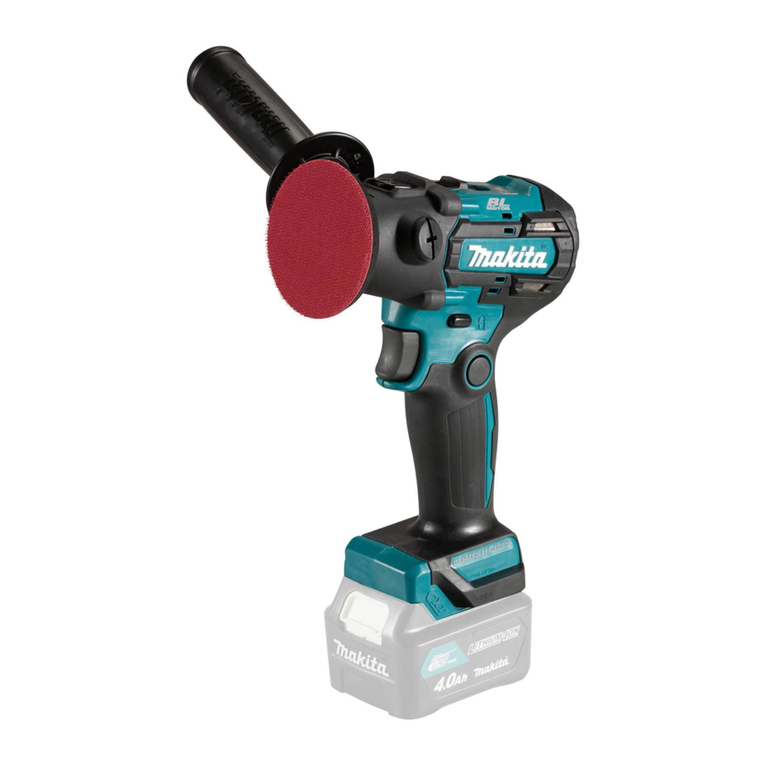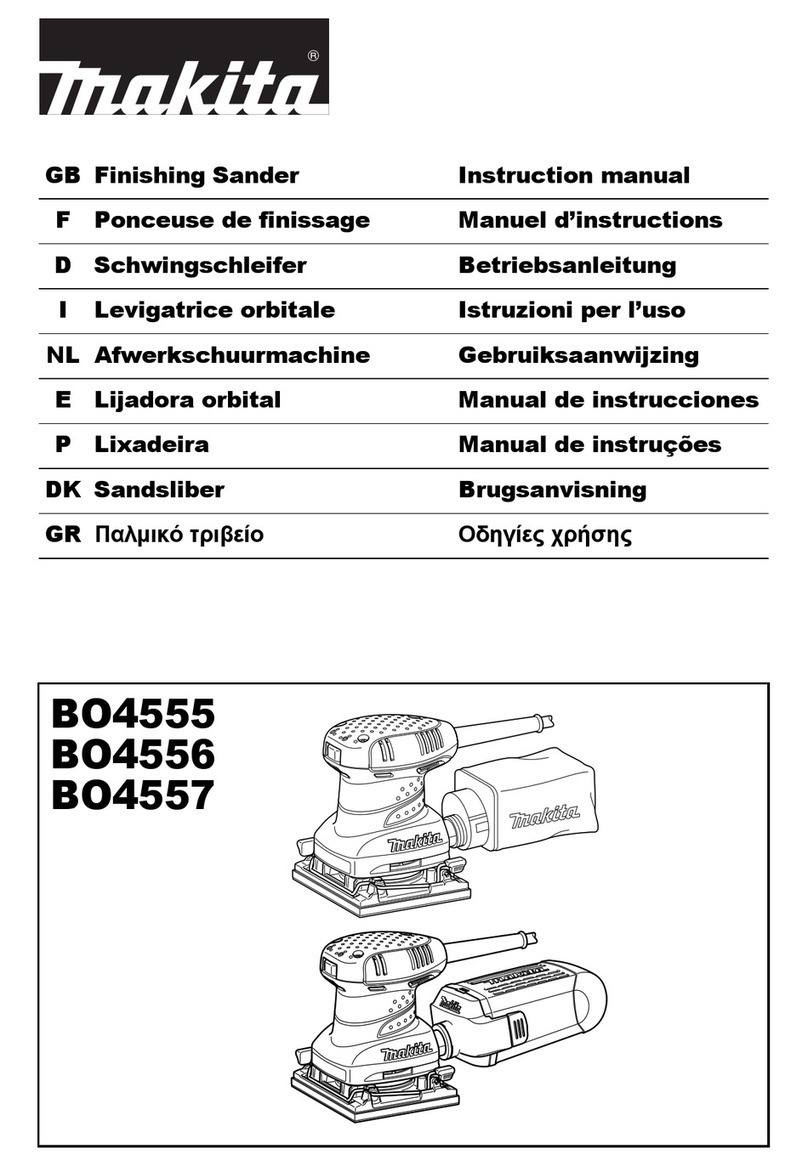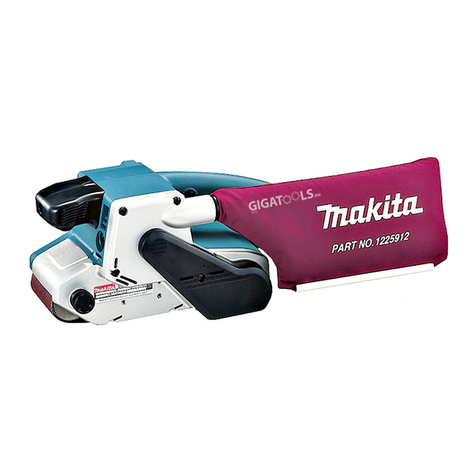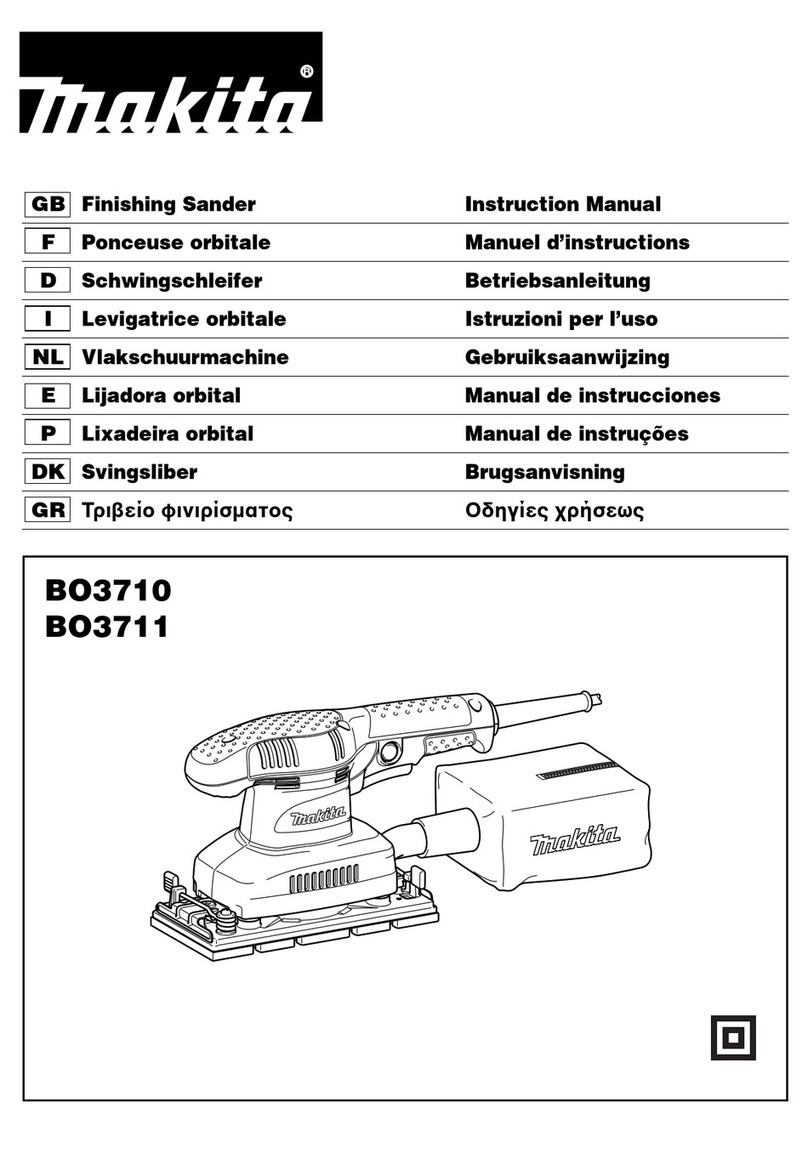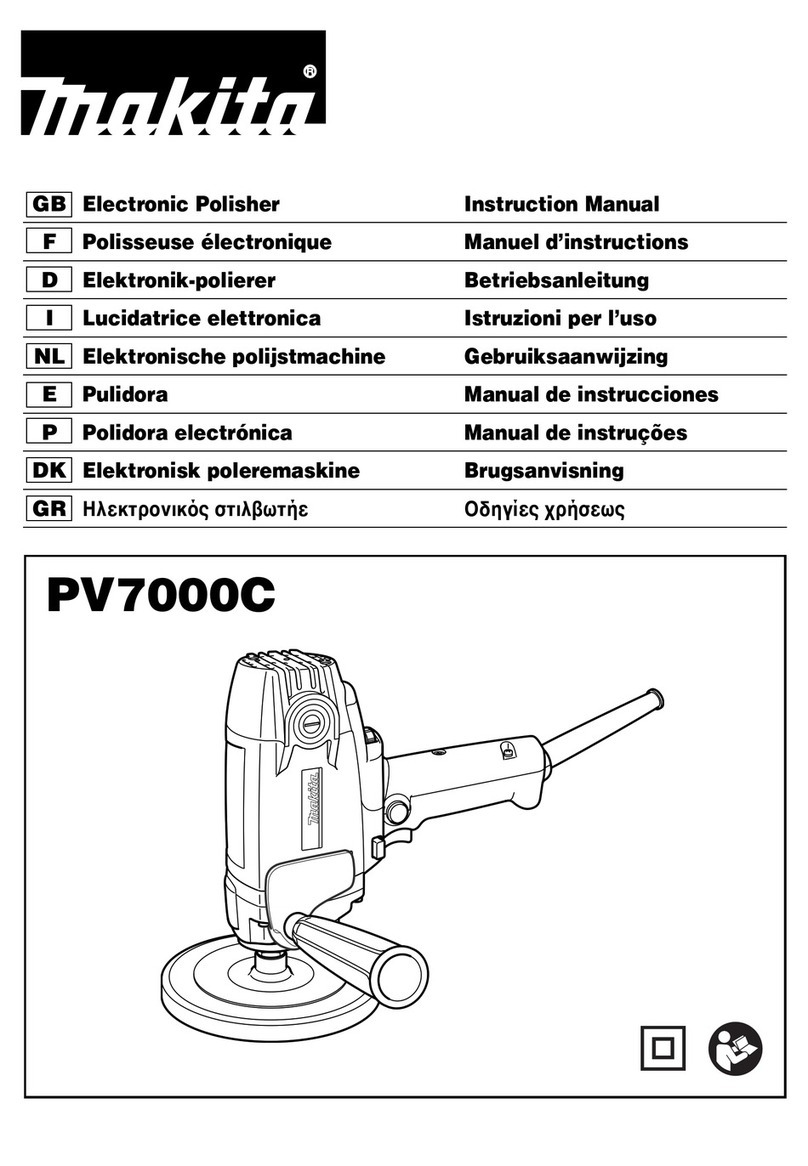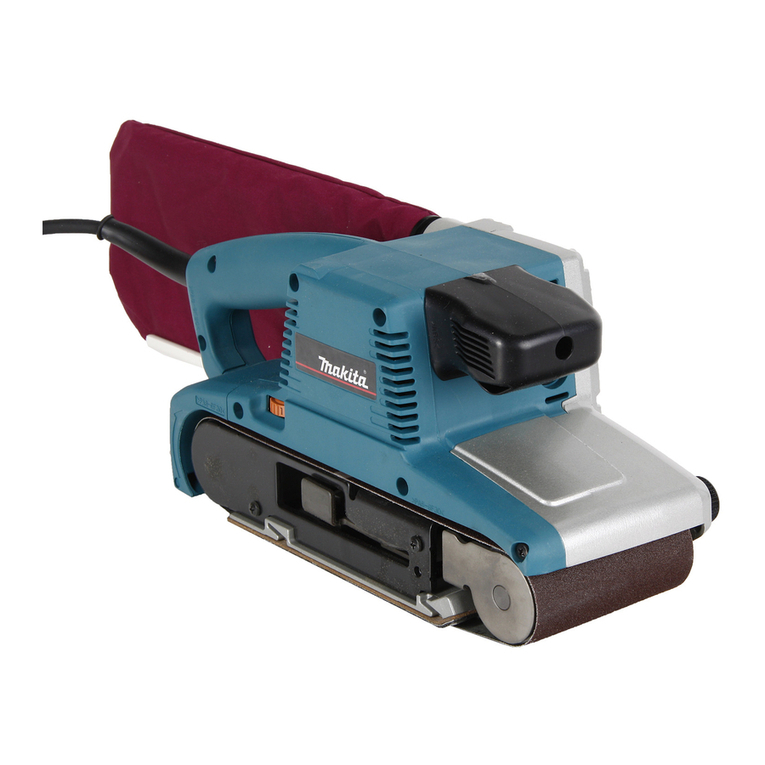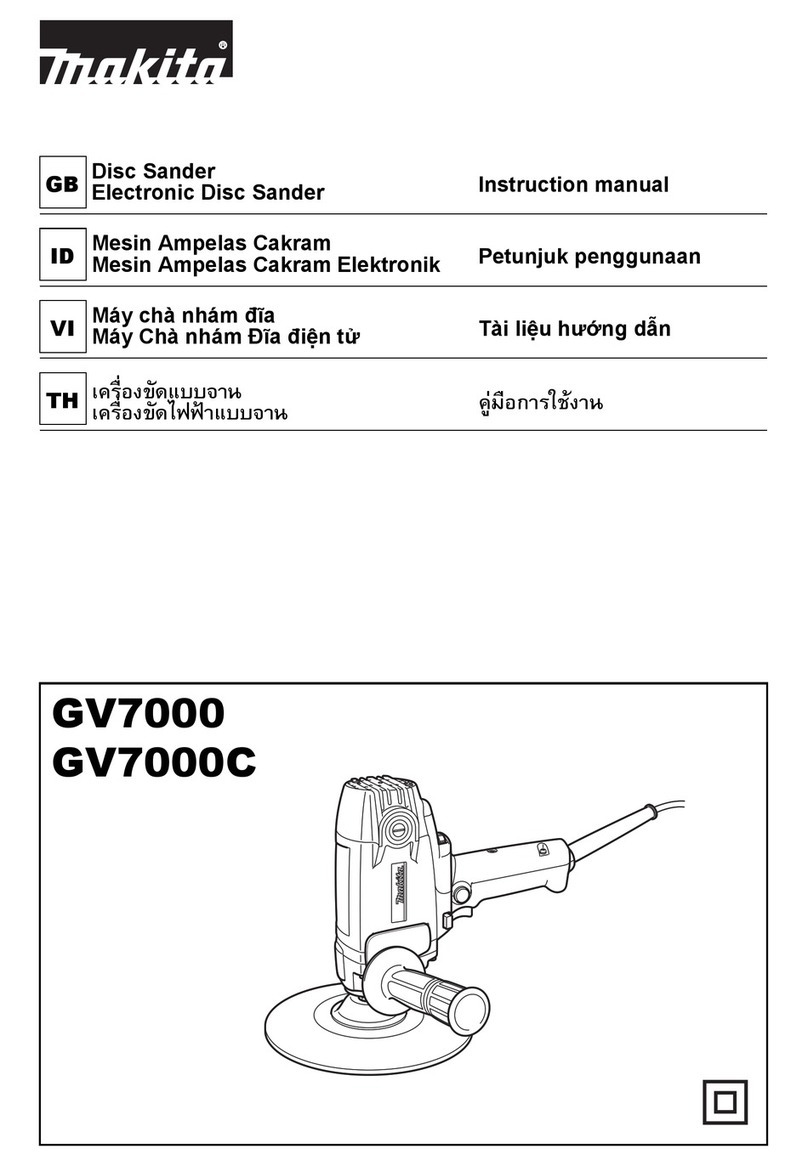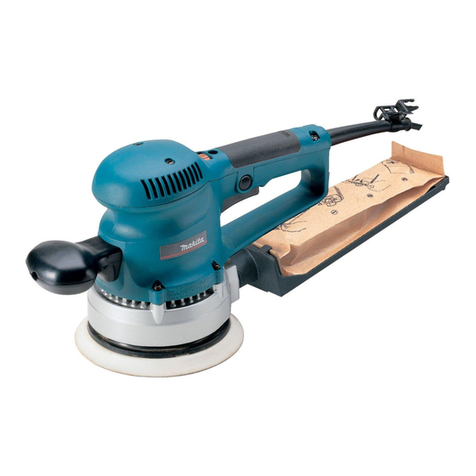16
NEDERLANDS
Verklaring van algemene gegevens
1 Schuurschijf
2 Zijhandgreep
3 Schroef
4 Steunschijf
5 Zeskantsleutel
6 Schakelaar
7 Snelheidsregelknop
8 Omschakelknop
9 Roterend-uitslaand modus
10 Willekeurige modus
11 Stofuitlaat
12 Manchet
13 Slang
14 Verbindingsstuk
15 Sponsrubberen schijf
16 Vilten schijf
17 Wollen schijf
TECHNISCHE GEGEVENS
Model BO6040
Diameter steunschijf ........................................... 150 mm
Diameter schuurschijf ......................................... 150 mm
Omwentelingen per minuut ........................ 1 600 – 5 800
Totale lengte ....................................................... 316 mm
Netto gewicht ......................................................... 2,7 kg
• In verband met ononderbroken research en ontwikke-
ling behouden wij ons het recht voor bovenstaande
technische gegevens te wijzigen zonder voorafgaande
kennisgeving.
• Opmerking: De technische gegevens kunnen van land
tot land verschillen.
Stroomvoorziening
Het gereedschap mag alleen worden aangesloten op
een stroombron van hetzelfde voltage als aangegeven op
de naamplaat, en kan alleen op enkel-fase wisselstroom
worden gebruikt. Het gereedschap is dubbel-geïsoleerd
volgens de Europese standaard en kan derhalve ook op
een niet-geaard stopkontakt worden aangesloten.
Veiligheidswenken
Voor uw veiligheid dient u de bijgevoegde Veiligheids-
voorschriften nauwkeurig op te volgen.
AANVULLENDE
VEILIGHEIDSVOORSCHRIFTEN
Laat u NIET misleiden door een vals gevoel van com-
fort en bekendheid met het gereedschap (na veelvul-
dig gebruik) en neem alle veiligheidsvoorschriften
van de schuurmachine altijd strikt in acht. Bij onvei-
lig of verkeerd gebruik van het elektrisch gereed-
schap, bestaat de kans op ernstig persoonlijk letsel.
1. Houd elektrisch gereedschap vast aan het geïso-
leerde oppervlak van de handgrepen wanneer u
werkt op plaatsen waar het zaaggereedschap
met verborgen bedrading of zijn eigen snoer in
aanraking kan komen. Door contact met onder
spanning staande draden, zullen de niet-geïso-
leerde metalen delen van het gereedschap onder
spanning komen te staan zodat de gebruiker een
elektrische schok kan krijgen.
2. Draag altijd een veiligheidsbril. Een gewone bril
of een zonnebril is GEEN veiligheidsbril.
3. Houd het gereedschap stevig vast.
4. Schakel het gereedschap altijd uit als u weg
moet. Schakel het gereedschap alleen in wan-
neer u het vasthoudt.
5. Dit gereedschap is niet waterdicht. Besprenkel
derhalve het oppervlak van het werkstuk niet
met water.
6. Zorg dat uw werkplaats goed geventileerd is
wanneer u gaat schuren.
7. Sommige materialen bevatten chemicaliën die
giftig kunnen zijn. Pas op dat u het werkstof van
dergelijke materialen niet inademt en vermijd
contact met de huid.Volg de veiligheidsvoor-
schriften van de leverancier van het materiaal
op.
8. Als dit gereedschap wordt gebruikt voor het
schuren van bepaalde producten, verflagen en
hout, kan de gebruiker worden blootgesteld aan
stof waarin gevaarlijke bestanddelen zitten.
Gebruik geschikte ademhalingbeschermingsap-
paratuur.
9. Controleer voor het gebruik of de schuurschijf
niet gescheurd of gebroken is. Een gescheurde
of gebroken schijf kan persoonlijk letsel vero-
orzaken.
BEWAAR DEZE VOORSCHRIFTEN.
WAARSCHUWING:
VERKEERD GEBRUIK of het niet naleven van de vei-
ligheidsvoorschriften in deze gebruiksaanwijzing
kan leiden tot ernstige verwondingen.
BEDIENINGSVOORSCHRIFTEN
Installeren of verwijderen van de schuurschijf (Fig. 1)
Belangrijk:
• Kontroleer altijd of het gereedschap is uitgeschakeld en
de stekker van het netsnoer uit het stopkontakt is ver-
wijderd alvorens de schuurschijf te installeren of te ver-
wijderen.
• Gebruik altijd schuurschijven van het klittenband-type.
Gebruik nooit drukgevoelige schuurschijven.
Voor het installeren van de schuurschijf dient u eerst alle
vuil en stof van de steunschijf te verwijderen. Bevestig
vervolgens de schuurschijf op de steunschijf door middel
van het klittenband op de schuurschijf en steunschijf.
Zorg ervoor dat de gaten in de schuurschijf overeenko-
men met de gaten in de steunschijf.
Bevestigen van de zijhandgreep
(los verkrijgbaar accessoire) (Fig. 2)
Verwijder een van de schroeven waarmee het kopdeksel
is vastgezet. Schroef de zijhandgreep stevig vast op het
gereedschap. De zijhandgreep kan aan beide zijden van
het gereedschap worden bevestigd.
Verwisselen van de steunschijf (Fig. 3)
Makita biedt een uitgebreide keuze optionele super-
zachte, zachte en harde steunschijven. Draai de schroef
in het midden van de gereedschapsvoet linksom los met
de zeskantsleutel en verwijder deze. Nadat de steun-
schijf is verwisseld, draait u de schroef goed vast naar
rechts.
